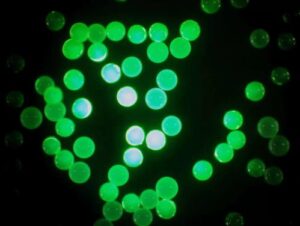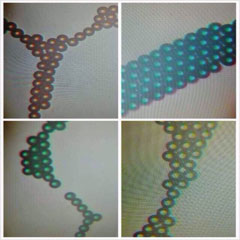Иммуномагнитные шарики (ИМБ) представляют собой комплекс, образованный путем связывания молекул с иммунной активностью, таких как антитела (или антигены), с поверхностью магнитных частиц посредством физической адсорбции, химического сшивания и других методов. Он обладает как специфичностью иммунного ответа, так и магнитной восприимчивостью. Магнитные частицы, как носители, обычно изготавливаются из магнитных материалов, таких как металлы (такие как железо, кобальт, никель и т. д.) или оксиды металлов (такие как оксид железа), при этом размеры частиц обычно варьируются от нанометров до микрометров.

Структура иммуномагнитные шарики: Магнитные шарики состоят из основных металлических частиц (Fe2O3, Fe3O4). Основной слой состоит из полимерных материалов, обернутых вокруг внешнего слоя (например, полистирола, поливинилхлорида), и функциональных лигандов на самом внешнем слое (например, – NH2, – COOH, – OH, – CHO).
Принцип работы
Стадия связывания иммунного ответа: Когда иммунные магнитные шарики добавляются к образцу, содержащему целевой антиген (или антитело), антитело (или антиген) на поверхности магнитных шариков будет специфически связываться с целевым антигеном (или антителом). Например, при обнаружении раковых клеток в крови антитела, конъюгированные со специфическими маркерами на поверхности раковых клеток (такими как молекулы адгезии эпителиальных клеток, EpCAM) на поверхности иммуномагнитных шариков, будут специфически связываться с EpCAM на поверхности раковых клеток, позволяя иммуномагнитным шарикам «захватывать» раковые клетки.
Стадия магнитного разделения: После завершения связывания применяется внешнее магнитное поле, и благодаря магнитным свойствам самих иммуномагнитных шариков они быстро отделяют связанные целевые молекулы (или клетки) от раствора образца. Например, помещение образца крови, содержащего комплекс иммуномагнитных шариков с раковыми клетками, в магнитное поле притянет иммуномагнитные шарики с раковыми клетками к одной стороне магнитного поля, в то время как другие компоненты (такие как клетки крови, белки плазмы и т. д.) останутся в растворе, тем самым достигая отделения раковых клеток от других компонентов.
Области применения иммуномагнитных шариков
1. Биомедицинские исследования
(1) Сортировка клеток
Магнитная сортировка с использованием шариков, также известная как иммунная магнитная сортировка клеток с использованием шариков, в основном использует антитела, нацеленные на специфические антигены клеточной поверхности, для маркировки клеток. Меченые клетки сшиваются с магнитными шариками и помещаются в магнитное поле для адсорбции для отбора или удаления. Благодаря своей скорости и простоте работы магнитная сортировка с использованием шариков является одним из наиболее часто используемых исследователями методов для разделения специфических субпопуляций клеток с высокой чистотой и активностью.
Существует множество сценариев, в которых высокоочищенные разделенные клетки могут использоваться для экспериментов по сортировке в области естественных наук, таких как моделирование заболеваний, исследования клеточной терапии, эксперименты по трансплантации адаптивных клеток на животных моделях, скрининг лекарственных препаратов in vitro и подготовка гибридом.
Иммуномагнитная сортировка клеток с помощью шариков позволяет отделять высокочистые клетки от сложных клеточных смесей в течение нескольких минут. При использовании наноразмерных магнитных шариков для сортировки клеток размер и состав шариков делают их биоразлагаемыми и не активируют и не влияют на функцию и жизнеспособность клеток. Физиологические функции клеток остаются неизменными, поэтому магнитную маркировку клеток можно немедленно использовать для анализа и последующих экспериментов.
(2) Разделение и очистка белков и антител
Технология иммуномагнитной очистки с использованием покрытия антителами (белками) не требует сложного хроматографического оборудования и не имеет ограничений по чистоте образца. Она требует только простого шага магнитной адсорбции для легкого отделения моноклональных антител от продуктов их экспрессии, эффективно устраняя недостатки традиционной хроматографической технологии.
(3) Разделение и очистка нуклеиновых кислот
Связывание нуклеиновых кислот с магнитными шариками в основном основано на электростатических, гидрофобных и водородных связях. Под действием лизирующего буфера ДНК/РНК в клетках или тканях высвобождается. В этот момент поверхностно модифицированные суперпарамагнитные кремниевые наномагнитные шарики подвергаются «специфическому связыванию» с нуклеиновой кислотой, образуя «комплекс нуклеиновой кислоты и магнитных шариков». Затем под действием внешнего магнитного поля комплекс разделяется.
Его можно широко применять в исследованиях генома, молекулярной эволюции, генетических заболеваниях в медицине, обнаружении мутаций генов, скрининге опухолей, тестировании на ВПЧ, типировании HLA, подборе трансплантатов, судебно-биологическом исследовании образцов крови, пятен спермы, волос, окурков и других испытаний доказательств на месте, а также в судебно-медицинском тестировании на отцовство, определении кровного родства, археологии, биологических экспериментах в начальных, средних и высших школах и во многих других областях.
- Обнаружение и обогащение патогенов: в микробиологических исследованиях иммуномагнитные шарики могут использоваться для обнаружения и обогащения определенных патогенов. Например, при обнаружении патогенной E. coli в пище иммуномагнитные шарики, конъюгированные с антителами против E. coli, добавляются в пищевой экстракт. После того, как магнитные шарики связываются с E. coli, присутствие и количество E. coli определяются с помощью магнитного разделения и последующих методов обнаружения, таких как культивирование и ПЦР.
2. Клиническая диагностика и лечение
(1) Диагностика и мониторинг опухолей: при ранней диагностике рака иммуномагнитные шарики могут использоваться для обогащения циркулирующих опухолевых клеток (CTC) в крови, которые могут служить биомаркерами для ранней диагностики опухолей, оценки эффективности лечения и мониторинга рецидивов. Например, обнаруживая CTC в крови пациентов с раком легких, врачи могут понять метастазы опухоли и оценить эффективность планов лечения.
(2) Иммунотерапия: В некоторых методах иммунотерапии иммуномагнитные шарики могут служить носителями для доставки иммунных регуляторных молекул. Например, связывание иммуностимулирующих факторов с иммуномагнитными шариками и доставка их к иммунным клеткам (таким как Т-клетки) посредством специфического связывания магнитных шариков усиливает их иммунную активность и используется для лечения некоторых аутоиммунных заболеваний или опухолей.
- Тестирование безопасности пищевых продуктов
Может использоваться для обнаружения вредных микроорганизмов (таких как сальмонелла, листерия и т. д.), токсинов (таких как афлатоксин) или генетически модифицированных ингредиентов в пищевых продуктах. Например, путем добавления иммуномагнитных шариков, конъюгированных с антителами против сальмонеллы, к экстракту образцов пищевых продуктов, магнитное разделение и последующее обнаружение могут быстро и чувствительно обнаружить присутствие сальмонеллы, обеспечивая безопасность пищевых продуктов.
Преимущества иммуномагнитных шариков
- Сильная специфичность
Благодаря специфическому связыванию антигенов и антител можно точно идентифицировать и захватывать целевые молекулы или клетки, эффективно снижая неспецифическую адсорбцию и фоновые помехи, а также повышая точность обнаружения и разделения.
- Высокая эффективность разделения
Под действием внешнего магнитного поля иммуномагнитные частицы могут быстро отделяться от жидкой фазы субстрата и обогащать целевые молекулы из сложных биологических образцов, значительно сокращая время разделения и повышая эффективность работы.
- Легко эксплуатировать
Он не требует сложных инструментов и оборудования и подходит для полностью автоматизированных рабочих станций. Он может обеспечить автоматическое извлечение одним щелчком, уменьшая сложность и ошибки ручного управления.
- Хорошая устойчивость
Он обладает хорошей физической и химической стабильностью и может сохранять свои характеристики в различных экспериментальных условиях, обеспечивая надежность экспериментальных результатов.
- Разнообразные функции
Его можно комбинировать с различными методами обнаружения и анализа, такими как флуоресцентная маркировка, хемилюминесценция и т. д., для достижения высокочувствительного обнаружения и количественного анализа целевых молекул. Его также можно использовать в различных областях, таких как очистка генов, очистка белков, очистка клеток, микробное обогащение и т. д.
Существующие проблемы иммуномагнитных шариков
Неспецифическое связывание: несмотря на высокую специфичность, в некоторых случаях все же может иметь место неспецифическое связывание, что приводит к ложноположительным результатам тестов и влияет на точность эксперимента.
Агрегация магнитных частиц: Неправильные условия хранения или внешние факторы могут привести к агрегации магнитных частиц, что приведет к уменьшению удельной площади поверхности и активности, а также к снижению эффективности связывания с целевыми молекулами.
Высокая цена: особенно это касается иммунных магнитных шариков, которые были специально модифицированы или функционализированы, высокая стоимость ограничивает их широкое применение в крупномасштабных экспериментах или клинических испытаниях.
Влияние на клеточную функцию: во время выделения и очистки клеток он может взаимодействовать с рецепторами клеточной поверхности или другими молекулами, мешать нормальным физиологическим функциям и биологическому поведению клеток, а также влиять на последующие исследования и приложения.
наше решение
Столкнувшись с этими проблемами, компания SHBC стремится предоставить вам более качественные иммуномагнитные гранулы!
Что касается предотвращения агрегации магнитных частиц, мы не только предоставляем профессиональные рекомендации по хранению и использованию, но и внедряем инновации и оптимизируем рецептуры продуктов для значительного повышения стабильности магнитных частиц, обеспечивая их хорошую диспергируемость и активность в различных средах.
В ответ на проблемы со стоимостью мы оптимизируем производственные процессы и интегрируем ресурсы начального и конечного звена, чтобы гарантировать высокое качество продукции при минимизации цен, что упрощает использование нашей продукции большим количеством клиентов и способствует развитию нашей работы.
Что касается защиты клеточных функций, наши продукты прошли тщательную экспериментальную проверку с целью минимизации вмешательства в нормальные физиологические функции клеток, гарантируя, что клетки, полученные в процессе выделения и очистки, сохранят свои первоначальные биологические характеристики, что является надежной гарантией для последующих экспериментальных исследований.
Наши иммунные магнитные шарики
Shanghai Taoyu является мировым производителем диагностических реагентов, специализируясь на продаже основного сырья для диагностических реагентов. Shanghai Taoyu имеет передовые диагностические микросферы, включая иммуноанализ, иммунохроматографию, хемилюминесценцию, секвенирование генов, извлечение нуклеиновых кислот и четыре типа высококачественных микросферических магнитных шариков. Мы можем предоставить высококачественное и надежное основное сырье для мировых компаний по производству диагностических реагентов, больниц, университетов и т. д. На сегодняшний день существует более 600 глобальных партнеров, включая серию микросфер с любым размером и однородным размером частиц в диапазоне от 20 нанометров до 1000 микрометров.
Продукция включает карбоксильные микросферы, полистирольные микросферы, флуоресцентные микросферы, флуоресцентные микросферы с временным разрешением, цветные микросферы, магнитные микросферы, кремниевые магнитные шарики, микросферы ПММА, фотодиффузионные микросферы, жидкокристаллические разделительные микросферы, микросферы для порообразующих агентов, стандартные частицы и полимерные наполнители для обращенно-фазовой хроматографии.
Производительность продукции достигла или даже превзошла производительность аналогичной продукции известных брендов. Shanghai Taoyu с нетерпением ждет возможности работать с вами, чтобы вместе создать лучшее будущее!

